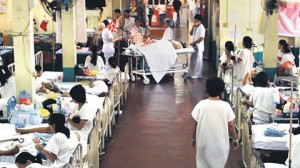Mercury spill at Manila’s Fabella hospital
MANILA, Philippines—The Department of Health on Saturday ordered a clean-up of a “chemical spill” at a government-run maternity hospital known as a “baby factory” due to the immensely large number of women from the lower income brackets who go there to give birth.
Health Assistant Secretary Eric Tayag said a clean-up was under way at the Fabella Memorial Hospital in Sta. Cruz, Manila after an initial assessment showed unacceptable mercury levels in several areas “in and around the storage room.”
He said Health Secretary Enrique Ona had directed the Fabella hospital officials and staff to prioritize patient safety after mercury reportedly spilled from a broken container in the storage room on August 8.
It was not clear why a maternity hospital, known as a baby factory for having the biggest number of births in any Philippine hospital every year, would have in storage a large amount of mercury dental amalgam whose use for dental filling has been largely discontinued.
“Forty patients from the Pediatric ward adjacent to the area of spill were already transferred to another ward in the hospital as a precautionary measure,” Tayag said in a statement.
Article continues after this advertisement“Fabella will continue to accept and care for patients as current assessment do not require any evacuation,” he added.
Article continues after this advertisementTayag said a DOH response team was working with the Hazardous Material Unit of the Bureau of Fire Protection to determine the extent of the chemical spill and to initiate remediation procedures.
“Secretary Ona laments that this incident happened and ordered a review of proper and safe storage and disposal of harmful chemicals, particularly mercury, in all hospitals to prevent a similar incident from happening again,” Tayag said.
He said Fabella was one of health facilities that had discontinued the use of mercury-containing medical devices after the DOH ordered their phase-out in 2008.
“All health facilities were ordered to comply with the mercury ban by 2010,” Tayag said.
He added that the DOH was examining possibly exposed individuals following the mercury spill and will monitor them for possible health effects.
Tayag said the DOH was still trying to determine how the spill happened. He said the mercury was still in the storage room because its disposal needed the supervision of the Department of Environment and Natural Resources.
“The final disposal of mercury needs to be supervised by the DENR. We are still looking for answers,” Tayag said. It was not clear why, if it had already been notified, the DENR has so far not done anything about its disposal.
Tayag said the mercury apparently evaporated after it spilled from its containers in the storeroom.
“What we know was that the amalgam spill was discovered where it was temporarily stored in a separate building away from patient areas after the DOH-issued mercury ban in 2008,” he added.
Tayag said the DOH was also trying to find out if other areas around the storeroom were also contaminated “to make sure no one gets exposed.”
“When mercury vapor is inhaled, it goes to the brain and affects the central nervous system. High exposures can cause respiratory difficulty and even death,” he said.
